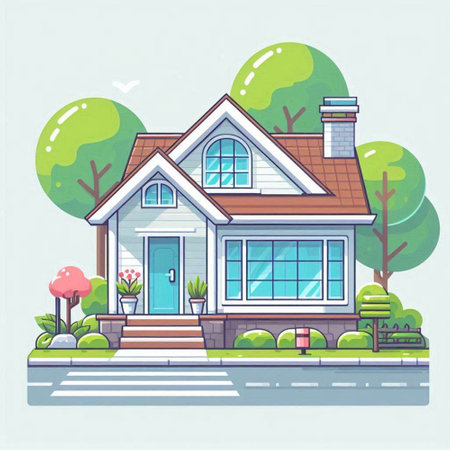Introduction to Sustainable Design
Sustainable interior design is more than just a trend—its a lifestyle choice that is quickly becoming the new standard in American homes. As more people become aware of environmental issues and the impact of their daily choices, sustainable design offers a way to create beautiful, functional spaces while caring for the planet.
What Is Sustainable Interior Design?
Sustainable interior design focuses on using materials and practices that reduce negative impacts on the environment. This includes choosing renewable, recycled, or low-impact resources, reducing waste, conserving energy, and improving indoor air quality. The goal is to create interiors that are not only stylish but also healthy and environmentally responsible.
Why It Matters in Modern American Homes
In the U.S., homeowners are increasingly seeking ways to make their living spaces more eco-friendly. Whether its due to climate change awareness, health concerns, or simply wanting to reduce utility bills, sustainable design is gaining popularity. It aligns with broader movements like minimalism and wellness-focused living, making it a natural fit for modern lifestyles.
Benefits of Sustainable Interior Design
| Benefit | Description |
|---|---|
| Healthier Living Environment | Reduces exposure to toxic chemicals found in conventional materials. |
| Energy Efficiency | Lowers energy consumption through smart design and efficient appliances. |
| Cost Savings | Long-term savings from durable materials and lower utility bills. |
| Environmental Impact | Decreases carbon footprint by using renewable or recycled resources. |
| Aesthetic Appeal | Modern sustainable materials offer stylish and versatile design options. |
Core Principles of Sustainable Design
- Use of Eco-Friendly Materials: Prioritize non-toxic, recyclable, and biodegradable products.
- Energy Conservation: Incorporate lighting, insulation, and appliances that reduce energy use.
- Waste Reduction: Reuse existing furniture or opt for reclaimed wood and upcycled décor.
- Water Efficiency: Install water-saving fixtures and consider drought-tolerant plants indoors.
- Indoor Air Quality: Choose paints, adhesives, and finishes with low or no VOCs (volatile organic compounds).
A Lifestyle That Makes a Difference
Sustainable interior design isnt just about saving the planet—its about creating homes that support your well-being. By choosing eco-conscious materials and practices, youre investing in a healthier life for you and future generations. As we move forward in this guide, well explore the best sustainable materials available today and how you can incorporate them into your own home with style and purpose.
2. Eco-Friendly Flooring Options
When it comes to sustainable interior design in modern American homes, flooring plays a huge role—not just in the look and feel of your space, but also in its environmental footprint. Choosing eco-friendly flooring options means youre picking materials that are better for the planet, healthier for your home, and often more durable over time.
Reclaimed Wood
Reclaimed wood is sourced from old barns, factories, or warehouses and given new life as flooring. Its full of character, with unique textures and colors that add warmth and history to any room. Plus, by reusing existing wood, youre reducing demand for new lumber and helping to preserve forests.
Benefits of Reclaimed Wood:
- Durability: Often made from old-growth timber, which is denser and stronger than new wood.
- Aesthetics: Rich patina and unique imperfections give it a timeless appeal.
- Eco-Friendly: No new trees are cut down; reduces landfill waste.
Bamboo Flooring
Bamboo is technically a grass, but its harder than many types of hardwood. It grows rapidly—some species can grow up to three feet in just one day—making it one of the most renewable materials on the planet. Its sleek, stylish, and works well in both traditional and contemporary interiors.
Benefits of Bamboo Flooring:
- Durability: Comparable to oak or maple when properly processed.
- Aesthetics: Clean lines and modern finish options.
- Sustainability: Rapid regrowth makes it highly renewable.
Cork Flooring
Cork comes from the bark of cork oak trees, which naturally regenerates after harvesting. Its soft underfoot, naturally insulating, and has antimicrobial properties that resist mold and mildew—great for allergy sufferers!
Benefits of Cork Flooring:
- Comfort: Cushiony feel thats easy on joints.
- Aesthetics: Warm tones with natural texture.
- Sustainability: Harvested without harming the tree; biodegradable.
Recycled Materials
Flooring made from recycled content—like rubber, glass tiles, or composite woods—offers an innovative way to reduce waste while creating a one-of-a-kind look. These materials often come in bold colors or patterns that make a statement in any space.
Benefits of Recycled Material Flooring:
- Durability: Engineered for high traffic areas; long-lasting performance.
- Aesthetics: Unique designs not found in traditional flooring.
- Sustainability: Diverts waste from landfills; supports circular economy.
Comparison Table: Sustainable Flooring Options
| Material | Main Benefits | Aesthetic Style | Sustainability Rating |
|---|---|---|---|
| Reclaimed Wood | Strong, rustic charm, eco-conscious reuse | Vintage / Traditional | ★★★★★ |
| Bamboo | Tough, modern look, fast renewable resource | Modern / Minimalist | ★★★★☆ |
| Cork | Cushioned feel, hypoallergenic, renewable bark source | Naturally Warm / Cozy | ★★★★★ |
| Recycled Materials | Diverse styles, repurposed content, durable surfaces | Creative / Eclectic | ★★★★☆ |
No matter which material you choose, opting for sustainable flooring helps you create a beautiful home while supporting environmentally responsible practices. Whether youre remodeling or building new, these eco-friendly options bring long-term value and peace of mind.

3. Low-VOC Paints and Finishes
When it comes to creating a sustainable and healthy home environment, choosing the right paints and finishes is just as important as selecting furniture or flooring. Traditional paints often contain high levels of Volatile Organic Compounds (VOCs), which are chemicals that easily become vapors or gases. These can negatively affect indoor air quality and even contribute to health issues such as headaches, dizziness, and respiratory problems.
What Are Low-VOC and Zero-VOC Paints?
Low-VOC and zero-VOC paints are specially formulated to emit fewer harmful chemicals into the air. These eco-friendly alternatives help reduce indoor pollution and support a healthier living space—something every modern American home should aim for.
| Type | VOC Level | Benefits |
|---|---|---|
| Traditional Paint | >250 g/L | High durability but poor air quality |
| Low-VOC Paint | < 50 g/L | Improved air quality, widely available |
| Zero-VOC Paint | < 5 g/L | Best for sensitive individuals and children |
Why It Matters in American Interior Design
In the U.S., green building standards like LEED (Leadership in Energy and Environmental Design) encourage or require the use of low- or zero-VOC products in both residential and commercial construction. This not only promotes environmental responsibility but also aligns with the growing demand among American homeowners for safer, cleaner, and more sustainable interiors.
Common Uses for Low-VOC Finishes
- Walls: Use low-VOC paint to cover large surface areas without compromising indoor air quality.
- Cabinets & Furniture: Choose low-VOC stains or sealants to maintain beautiful finishes while reducing toxic exposure.
- Floors: Water-based polyurethane with low VOC content is ideal for hardwood floors.
Pro Tip:
Always check product labels for VOC levels, and look for certifications like Green Seal or GREENGUARD to ensure youre making an eco-conscious choice.
4. Recycled and Upcycled Furnishings
One of the easiest and most creative ways to bring sustainability into your home is by choosing furniture made from recycled or upcycled materials. In modern American interior design, this approach not only reduces waste but also adds unique character to your living space.
Why Choose Recycled or Upcycled Furniture?
Recycled and upcycled furnishings help reduce landfill waste, lower demand for new raw materials, and often support local artisans and small businesses. These pieces can tell a story, blending history with modern style in a way that mass-produced items cannot.
Key Benefits
| Benefit | Description |
|---|---|
| Environmental Impact | Less energy is used compared to manufacturing new furniture, reducing carbon emissions. |
| Support Local Artisans | Many upcycled pieces are handcrafted by local makers, helping sustain local economies. |
| Unique Aesthetic | No two pieces are exactly alike, offering a one-of-a-kind look for your home. |
| Cost-Effective | Often more affordable than brand-new designer furniture, especially when DIY-ing. |
Popular Materials Used in Recycled and Upcycled Furniture
- Reclaimed Wood: Sourced from old barns, factories, or shipping pallets. It adds rustic charm and durability.
- Metal: Industrial-style furniture often includes repurposed steel or iron components.
- Glass: Old windows or bottles can be transformed into tabletops or decorative features.
- Textiles: Vintage fabrics can be reimagined into cushions, upholstery, or wall art.
Tips for Incorporating Recycled Pieces at Home
Start Small
You don’t have to redesign your entire home. Try adding a reclaimed wood coffee table or a vintage chair to begin.
Mix and Match
Blend recycled items with modern décor for an eclectic yet cohesive look.
DIY Projects
If youre handy, consider giving old furniture new life with paint, stain, or new hardware. It’s a fun weekend project that makes a difference.
Example: Easy DIY Upcycle Ideas
- Pallet wood turned into wall shelves
- An old dresser converted into a bathroom vanity
- Mason jars reused as pendant lights or planters
Selecting recycled and upcycled furnishings is more than just a trend—its a meaningful choice that supports sustainability while giving your home a unique personality. By embracing these options, you contribute to a greener future without sacrificing style or comfort.
5. Energy-Efficient Fixtures and Smart Home Tech
Creating a sustainable home isnt just about the materials you use—its also about how your home functions daily. In modern American interior design, energy-efficient lighting, appliances, and smart home technology are key components that save power and reduce environmental impact while blending seamlessly into stylish, contemporary spaces.
Sustainable Lighting Options
Lighting plays a major role in both the ambiance and energy usage of a home. Switching to eco-friendly lighting is one of the easiest ways to make your interior more sustainable. LEDs (Light Emitting Diodes) are a popular choice in modern American homes for their long lifespan and low energy consumption. They come in various color temperatures and styles, making them perfect for any room aesthetic—from farmhouse kitchens to minimalist living rooms.
Benefits of LED Lighting
| Feature | LED Lights |
|---|---|
| Energy Use | Up to 80% less than incandescent bulbs |
| Lifespan | 15,000–50,000 hours |
| Design Versatility | Available in various shapes and tones |
| Heat Emission | Minimal, improving safety and comfort |
ENERGY STAR-Rated Appliances
When selecting appliances for your kitchen, laundry room, or HVAC system, look for the ENERGY STAR label. This certification means the appliance meets strict efficiency guidelines set by the U.S. Environmental Protection Agency. These appliances not only lower your utility bills but also support your eco-conscious lifestyle without sacrificing performance or style.
Popular ENERGY STAR Appliances in Modern Homes
- Refrigerators with smart cooling systems
- Front-loading washers using less water and energy
- Dishwashers with soil sensors and efficient drying options
- HVAC systems with programmable thermostats for better climate control
Smart Home Technologies That Save Energy
Smart home tech has evolved from being a luxury to an integral part of sustainable living. By automating your homes energy use, you can significantly reduce waste while enjoying greater convenience.
Top Smart Home Devices for Energy Efficiency
| Device Type | Sustainability Benefit |
|---|---|
| Smart Thermostats (e.g., Nest, Ecobee) | Optimize heating/cooling schedules based on occupancy patterns |
| Smart Plugs & Power Strips | Cut off power to idle electronics automatically |
| Motion Sensor Lights | Turn lights on/off based on room usage to avoid waste |
| Smart Blinds/Shades | Regulate indoor temperature by controlling natural light access |
| Home Energy Monitors (e.g., Sense) | Track real-time electricity usage to identify areas for improvement |
The combination of these technologies allows homeowners to create interiors that are not only visually appealing but also environmentally responsible. Whether youre renovating or building new, integrating energy-efficient fixtures and smart tech ensures your space reflects both modern American design trends and sustainable living values.
6. Sourcing Materials Responsibly
When it comes to designing a modern American home with sustainability in mind, choosing the right materials is more than just picking something that looks good. Its about understanding where your materials come from, how theyre made, and whether they align with eco-friendly and ethical practices. Heres how you can source materials responsibly for your interior design projects.
Understand Eco-Certifications
Eco-certifications help identify products that meet specific environmental and ethical standards. Look for these labels when shopping for building supplies, furniture, flooring, textiles, and more:
| Certification | What It Means |
|---|---|
| FSC (Forest Stewardship Council) | Wood comes from responsibly managed forests. |
| GREENGUARD | Products have low chemical emissions, improving indoor air quality. |
| Cradle to Cradle | Assesses product safety, recyclability, and environmental impact. |
| OEKO-TEX | Textiles are tested for harmful substances. |
Support Local Suppliers
Sourcing locally helps reduce the carbon footprint associated with transporting goods long distances. It also supports the local economy and often provides better insight into how products are made. When possible, choose American-made materials and work with local artisans or small businesses who prioritize sustainability.
Benefits of Buying Local:
- Reduces transportation emissions
- Encourages community growth
- Easier to verify sustainable practices
Verify Product Origins
A big part of responsible sourcing is knowing exactly where and how a product was made. Ask suppliers questions like:
- Where do the raw materials come from?
- Are workers treated fairly during production?
- Are any harmful chemicals used in the process?
This transparency helps ensure that youre not unintentionally supporting exploitative labor practices or environmentally damaging manufacturing methods.
Create a Checklist
Use a simple checklist when evaluating materials:
| Sourcing Criteria | Yes/No |
|---|---|
| Is it certified by a trusted eco-label? | |
| Is it sourced or made in the USA? | |
| Is the production process transparent? | |
| Does it contain recycled or renewable content? |
Sourcing responsibly doesnt have to be overwhelming. By focusing on certifications, buying local, and asking the right questions, you can make informed choices that support both your design goals and the environment.


